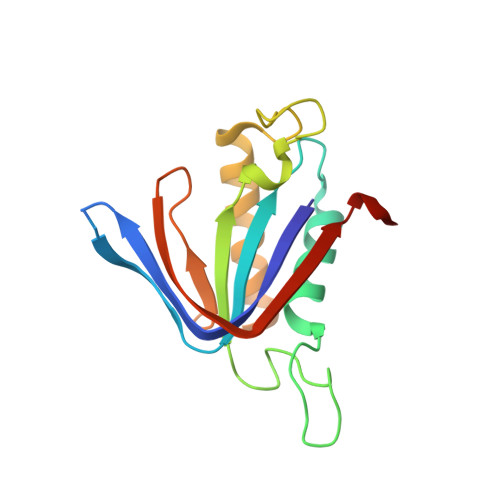Elongation Factor Tu Prevents Misediting of Gly-tRNA(Gly) Caused by the Design Behind the Chiral Proofreading Site of D-Aminoacyl-tRNA Deacylase
Routh, S.B., Pawar, K.I., Ahmad, S., Singh, S., Suma, K., Kumar, M., Kuncha, S.K., Yadav, K., Kruparani, S.P., Sankaranarayanan, R.(2016) PLoS Biol 14: e1002465-e1002465
- PubMed: 27224426
- DOI: https://doi.org/10.1371/journal.pbio.1002465
- Primary Citation of Related Structures:
5J61 - PubMed Abstract:
D-aminoacyl-tRNA deacylase (DTD) removes D-amino acids mischarged on tRNAs and is thus implicated in enforcing homochirality in proteins. Previously, we proposed that selective capture of D-aminoacyl-tRNA by DTD's invariant, cross-subunit Gly-cisPro motif forms the mechanistic basis for its enantioselectivity. We now show, using nuclear magnetic resonance (NMR) spectroscopy-based binding studies followed by biochemical assays with both bacterial and eukaryotic systems, that DTD effectively misedits Gly-tRNAGly. High-resolution crystal structure reveals that the architecture of DTD's chiral proofreading site is completely porous to achiral glycine. Hence, L-chiral rejection is the only design principle on which DTD functions, unlike other chiral-specific enzymes such as D-amino acid oxidases, which are specific for D-enantiomers. Competition assays with elongation factor thermo unstable (EF-Tu) and DTD demonstrate that EF-Tu precludes Gly-tRNAGly misediting at normal cellular concentrations. However, even slightly higher DTD levels overcome this protection conferred by EF-Tu, thus resulting in significant depletion of Gly-tRNAGly. Our in vitro observations are substantiated by cell-based studies in Escherichia coli that show that overexpression of DTD causes cellular toxicity, which is largely rescued upon glycine supplementation. Furthermore, we provide direct evidence that DTD is an RNA-based catalyst, since it uses only the terminal 2'-OH of tRNA for catalysis without the involvement of protein side chains. The study therefore provides a unique paradigm of enzyme action for substrate selection/specificity by DTD, and thus explains the underlying cause of DTD's activity on Gly-tRNAGly. It also gives a molecular and functional basis for the necessity and the observed tight regulation of DTD levels, thereby preventing cellular toxicity due to misediting.
Organizational Affiliation:
CSIR-Centre for Cellular and Molecular Biology, Hyderabad, India.




















